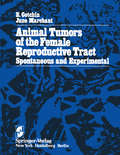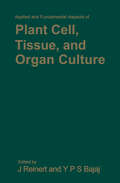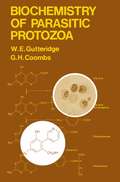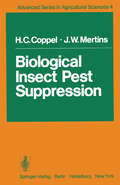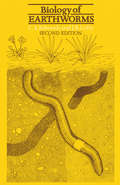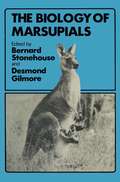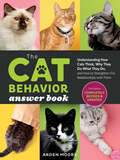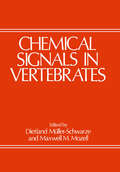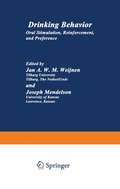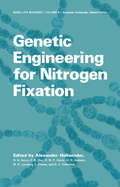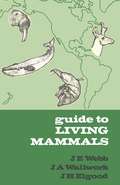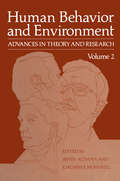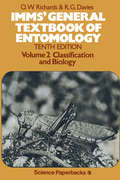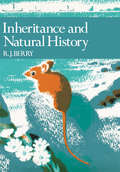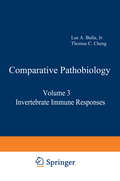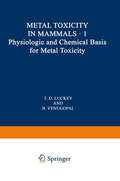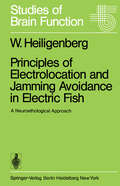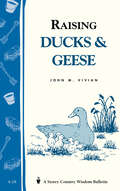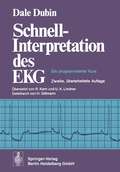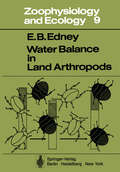- Table View
- List View
Animal Tumors of the Female Reproductive Tract: Spontaneous and Experimental
by E. Cotchin J. MarchantThe chapters which comprise this book were prepared as part of a medical text, Pathology of the Female Genital Tract, which is intended for the obstetrician, gynecologist, and medical pathologist. In that context, we were con cerned to bring out the importance of the study of tumors of the female reproductive tract of animals, both as show ing the variety of spontaneous neoplasms that might affect the tract and as providing tumors capable of experimental reproduction. These chapters are published separately, since they contain information which may appeal to a range of readers who might not necessarily wish to acquire the full medical text-for example, to veterinary and comparative pathologists, cancer research workers, research workers in gynecology, experimental pathologists and endocrinologists, and possibly to others using animals in experimental and pharmaceutical studies. The survey of spontaneous tumors of the female repro ductive tract is largely concerned with tumors of the ovaries and uterus of domesticated animals, but attention is also given to laboratory animals, wild animals, and animals in zoos. The spontaneous tumors are well worth studying, not only because of their obvious clinical impor tance to veterinarians, but also because they might provide a stimulus for epidemiologic, etiologic, biologic, and ther apeutic investigations that may elucidate some of the problems related to their counterparts in humans.
Applied and Fundamental Aspects of Plant Cell, Tissue, and Organ Culture
by Jakob Reinert Yashpal S. BajajProgress in the field of plant cell and tissue culture has made this area of research one of the most dynamic and promising not only in plant physiology, cell biology and genetics but also in agriculture, forestry, horticulture and industry. Studies with plant cell cultures clearly have bearing upon a variety of problems as yet unsolved in basic and applied research. This was the compelling reason for assembling such a comprehensive source of information to stimulate students, teachers, and research workers. This book comprises 34 articles on regeneration of plants, vegetative propagation and cloning; haploids; cytology, cytogenetics and plant breeding; protoplasts, somatic hybridization and genetic engineering; plant pathology; secondary products and a chapter on isoenzymes, radiobiology, and cryobiology of plant cells. Particular attention has been paid to modern , fast-growing and fascinating disciplines - e.g. the induction of haploids, somatic hybridization and genetic manipulation by protoplast culture, which possess an enormous potential for plant improvement.
Biological Insect Pest Suppression (Advanced Series in Agricultural Sciences #4)
by H. C. Coppel J. W. MertinsThe subject area embraced by the term "biological control" in its classical sense is very broad indeed. The term itself was apparently first used in 1919 by the late Harry S. Smith, and was then used specifically in reference to the suppression of insect populations by the actions of their indigenous or introduced natural enemies. The California school of biological control specialists who followed in Smith's footsteps have traditionally differentiated "natural" biological control (by indigenous natural enemies) and "applied" biological control (by man-introduced natural enemies). Subsequently, the philosophy broadened beyond the original narrow concern with population suppression of insects (and especially pest insects), to embrace directed activities against mites or other arthropod pests, various invertebrate and vertebrate pests, weeds, and organisms producing disease in humans or their domestic animals and plants. The techniques used in these activities also multiplied beyond the original concern with natural enemies. The subjects area discussed in this book is, at the same time, broader and more restricted than that covered in other books on "biological control. " On the one hand, the treatment here is restrictive in that, with rare exception, we have limited ourselves to dealing only with ideas and examples involving the suppression of insect pests through human activity or intervention in the environment.
The Cat Behavior Answer Book, 2nd Edition: Understanding How Cats Think, Why They Do What They Do, and How to Strengthen Our Relationships with Them
by Arden MooreCats can be mysterious and cat owners are eager to understand their behavior and learn how to strengthen the bond between cats and humans. In the revised 2nd edition of The Cat Behavior Answer Book (77,000 copies in print), pet expert Arden Moore answers the many questions cat owners have, from the practical aspects of training, feeding, and caring to the puzzling aspects of behavior and communication. Do cats dream? What's the purpose of a cat's whiskers? How do I catproof my house? Why does my elderly cat howl at night? How can I train my cats not to jump upon the kitchen counter? Can I keep my cat from climbing the curtains? What's the best way to train a kitten to use the litter box? How can I eliminate the smell of cat urine? What's the best way to trim a cat's nails? Is it okay for my cat to eat grass? Arden Moore provides insightful answers to all these questions and many more, along with reassuring guidance on addressing the problems that can get in the way of living happily with a cat. The 2nd edition has been completely updated to reflect the most recent research and recommendations and redesigned in a larger, highly browsable format.
Chemical Signals in Vertebrates
by Dietland Muller-SchwarzeFrom June 6 to 9, 1976, about 140 participants (physiologists, chemists, ecologists, animal behaviorists, and psychologists) gathered in the Gideon Putnam Hotel at Saratoga Springs, New York for a symposium entitled "Chemical Signals in Vertebrates". The focus of this symposium, sponsored by the United States National Science Foundation, was on chemical communication in higher animals, most notably mammals. This included the chemical nature, production, and reception of chemical signals, and their modulating effects on behavior. Almost all the world's laboratories working in this area were represented. It was the first meeting of its kind, and although the physiological aspects of taste and smell on the one hand and insect pheromones on the other have previously been treated in several fine symposia, they have not before been treated as a back drop to chemical communication in vertebrates. The field of insect pheromones is well developed, with hundreds of active compounds identified. By contrast, in vertebrates only six mammalian phero mones in as many species had been identified chemically by 1976.
Drinking Behavior: Oral Stimulation, Reinforcement, and Preference
by J. WeijnenThis is the first book that is devoted entirely to a discussion of the effects on drinking behavior of sensory stimulation of the tongue and mouth. As Blass and Hall (J 976) have recently pointed out, there has been an overrejection of the emphasis by Cannon (1932) and Hull (1943) on the peripheral origins (e. g. , dry mouth, empty stomach) of the control of ingestive behavior. Thus most present-day investigators of drinking behavior have been concentrat ing on central mechanisms of control, to the neglect of the periphery. In this volume we have attempted to bring together much of the pertinent "peripheral" literature through originally written chapters that are concerned with the role of orosensory factors in the mediation of drinking and licking. Postingestive effects of fluids receive little attention. Indeed, two chapters deal with consummatory licking in the absence of intake of fluids. A good understanding of the consequences of orosensory stimulation on licking and drinking behavior requires insight into the functional anatomy of the tongue and mouth, the characteristics of the licking response and the problem of recording of licking behavior. Several chapters deal with these subjects. It has not only been a pleasure but also a privilege to edit this volume. We have learned much from the expert treatment of the different aspects of licking and drinking behavior by the chapters' authors.
Genetic Engineering for Nitrogen Fixation (Basic Life Sciences #9)
by Alexander HollaenderThere is a time in scientific research when a number of developments coincide making it possible to progress with a tough and complicated problem. It is believed that such a time has come in the area of biological nitrogen fixation. A better understanding of photosynthesis, cell hybridization, plasmid, and gene transfer between cells not necessarily genetically related, have opened new avenues of research. New developments in traditional genetics, cell biology, biochemistry, including enzyme chemistry, and plant physi ology have brought about the feeling this is a most appro priate time to pull together the different approaches in a conference where the lines of research could be discussed and thus help to speed up developments in this area. What makes biological nitrogen fixation especially im portant is the promise that a good understanding of the basic problem would help us to make organisms more amenable to fix nitrogen, not only in symbiosis with legumes, but also with other plant species and develop a wider variety of organisms with the ability to fix N • It will also 2 encourage a search for naturally occurring N2 fixing organ isms other than the traditional N2 fixers. Some success has already been encountered in this area. Success in broadening the field of nitrogen fixing would help to increase food supply, especially in de veloping countries which cannot afford to purchase synthetic nitrogen sources.
Human Behavior and Environment: Advances in Theory and Research Volume 2
by Irwin Altman Joachim F. WohlwillThe papers comprising this second volume of Human Behavior and the Environment represent, as do their predecessors, a cross section of current work in the broad area of problems dealing with interrelation ships between the physical environment and human behavior, at both the individual and the aggregate levels. Considering the two volumes as a unit, we have included papers covering a broad spectrum of problems ranging from the theoretical to the applied, and from the disciplinary-based to the interdisciplinary and professional. Approxi mately half of the papers are written by psychologists, with the remainder coming, in part, from such other disciplines as sociology, geography, and from such diverse applied and professional fields as natural recreation, landscape architecture, urban planning, and opera tions research. The volumes thus provide an overview of work on current topical problems. Yet, as the field is developing, specialization is inevitably increasing apace, and the editors as well as the publisher have become convinced of the desirability for futu're volumes in this series to be organized along topical lines, with successive volumes devoted to different aspects of this rather sprawling field. Thus, Volume 3, currently in the planning stage, will be devoted exclusively to the interaction of children with the physical environment, considered from diverse viewpoints, again including authors from diverse fields of specialization.
Imms’ General Textbook of Entomology: Volume 2: Classification and Biology
by O.W. Richards R.G. Daviesseem as appropriate now as the original balance was when Dr A. D. Imms' textbook was first published over fifty years ago. There are 35 new figures, all based on published illustrations, the sources of which are acknowledged in the captions. We are grateful to the authors concerned and also to Miss K. Priest of Messrs Chapman & Hall, who saved us from many errors and omissions, and to Mrs R. G. Davies for substantial help in preparing the bibliographies and checking references. London O. W. R. R. G. D. May 1976 Part III THEORDERSOFINSECTS THE CLASSIFICATION AND PHYLOGENY OF INSECTS The classification of insects has passed through many changes and with the growth of detailed knowledge an increasing number of orders has come to be recognized. Handlirsch (1908) and Wilson and Doner (1937) have reviewed the earlier attempts at classification, among which the schemes of Brauer (1885), Sharp (1899) and Borner (1904) did much to define the more distinctive recent orders. In 1908 Handlirsch published a more revolutionary system, incorporating recent and fossil forms, which gave the Collembola, Thysanura and Diplura the status of three independent Arthropodan classes and considered as separate orders such groups as the Sialoidea, Raphidioidea, Heteroptera and Homoptera. He also split up the old order Orthoptera, gave its components ordinal rank and regrouped them with some of the other orders into a subclass Orthopteroidea and another subclass Blattaeformia.
Inheritance and Natural History (Collins New Naturalist Library #61)
by R. J. BerryEver wondered why primroses have three sorts of flowers; or about pesticide resistance in rats and mice, mosquitoes and green-fly; antibiotic resistance in disease organisms – all are examples of genetical adjustment, explained in this book.
Invertebrate Immune Responses (Comparative Pathobiology #3)
by Lee A. Bulla Jr. Thomas C. ChengThis represents the third volume of the series entitled Comparative PathobioZogy. The chapters included represent the proceedings of a symposium held at Oregon State University, Corvallis, on August 16-22, 1975. The symposium was co-sponsored by the Society for Invertebrate Pathology (SIP) and the American Society of Zoologists (ASZ). In recent years there has been an impressive increase in interest in comparative immunology, i. e. , a comparative approach to understanding how animals, both vertebrates and invertebrates, defend themselves against nonself materials. Ever since Metchnikoff's pioneering studies during the late l800s on the role of phagocytes of invertebrates, which led to his theory of cellular immunity, invertebrates have been employed with increasing fre quency for studying cellular defense. Consequently, it is not surprising that included in the memberships of SIP and ASZ are a large number of individuals with an active interest in this area of research. As indicated by the chapters included in this volume, the animal models employed have been primarily molluscs and insects, although crustaceans and annelids have also been popular.
Physiologic and Chemical Basis for Metal Toxicity
by B. VenugopalOur purpose is to provide understanding for appropriate use of metals in a technical society. Knowledge of metal toxicity is needed for the preven tion, prediction, diagnosis, and therapy of adverse reactions from excess metals in mammals. Metal Toxicity in Mammals is presented in two volumes. Volume 1, Physiologic and Chemical Basis for Metal Toxic ity, provides the basis for understanding the toxic actions of metals recorded in Volume 2, Chemical Toxicity of Metals and Metalloids. The details and bases for many concepts summarized in Volume I are given, with appropriate references, in Volume 2. Thus, references for specific items in Volume 2 are not generally given in Volume 1. The authors reviewed the known toxicity of several heavy metals in anticipation of their use as multinutrient markers for NASA. As more and more metals were considered, the need for a complete review became obvious. This treatise supplants onerous searches of metal-toxicity litera ture up to 1975 and reviews the toxicity of all the metals of the periodic table on the basis of available relevant data. Books on pharmacological, nutritional, medical, veterinary, or industrial toxicity contain information about selected metals. More complete data about metals of public concern, such as mercury, lead, and cadmium, may be found in numerous books and reviews. The reader should refer to general texts and basic reference works, when specific references are not given, for general information.
Principles of Electrolocation and Jamming Avoidance in Electric Fish: A Neuroethological Approach (Studies of Brain Function #1)
by W. HeiligenbergThis booklet, together with the following two,-which are well under way and will succeed it at intervals of, we hope, no more than six months, sets the stage for a new editorial enterprise in the field of brain science. The accent is on the functional aspects of brains rather than on their develop ment, hence the title of the series. The central question being how neural activity is related to behavior, there will be, naturally, a wide scatter of sub jects, and Heiligenberg's monograph on electric fish may be considered typ ical of the expected standard deviation from the mean. Deviations in other directions may go as far as the sensory neuron, or brain theory, or aphasia, or farther. The next contributions planned for the series are: Precht, Neuronal Operations in the Vestibular System, and Movshon, Genes and Environment in the Development of the Visual Cortex. Our aim is to ap proach the central area by means of something like an evolving handbook of brain science. The individual monographs should describe promising and successful approaches, even in areas where the last word is far from being said. Besides originaI monographs and compounds of the author's own published papers, reviews are also we1come if they are more than the sum of the parts. The publisher promises speedy publication, and the editors will see that the manuscripts will be readable as well as interesting. Tübingen, Summer 1977 V.
Protein Crosslinking: Biochemical and Molecular Aspects (Advances in Experimental Medicine and Biology #86A)
by Mendel FriedmanThe word crosslinking implies durable combination of (usually large) distinct elements at specific places to create a new entity that has different properties as a result of the union. In the case of proteins, such crosslinking often results in important changes in chemical, functional, nutritional, and biomedical properties, besides physical properties simply related to molecular size and shape. (Nucleic acids, carbohydrates, and other biopolymers are correspondingly affected.) Since proteins are ubiquitous, the consequences of their crosslinking are widespread and often profound. Scientists from many disciplines including organic chemistry, bio chemistry, protein chemistry, food science, nutrition, radiation biology, pharmacology, physiology, medicine, and dentistry are, therefore, minutely interested in protein crosslinking reactions and their implications. Because protein crosslinking encompasses so many disciplines, in organizing the Symposium on Nutritional and Biochemical Conse quences of Protein Crosslinking sponsored by the Protein Subdivi sion of the Division of Agricultural and Food Chemistry of the American Chemical Society, I sought participants with the broadest possible range of interests, yet with a common concern for theore tical and practical aspects of protein crosslinking. An important function of a symposium is to catalyze progress by bringing together ideas and experiences needed for interaction among different, yet related disciplines. To my pleasant surprise, nearly everyone invited came to San Francisco to participate.
Protein Crosslinking: Nutritional and Medical Consequences (Advances in Experimental Medicine and Biology #86)
by Mendel FriedmanThe word crosslinking implies durable combination of usually large, distinct elements at specific places to create a new entity that has different properties as a result of the union. In the case of proteins, such crosslinking often results in important changes in chemical, physical, functional, nutritional, and biome dical properties, besides physical properties simply related to molecular size and shape. (Nucleic acids, carbohydrates~ glyco proteins, and other biopolymers are correspondingly affected.) Since proteins are ubiquitous, the consequences of their crosslin king are widespread and often profound. Scientists from many dis ciplines including organic chemistry, biochemistry, protein chemis try, food science, nutrition, radiation biology, pharmacology, physiology, medicine, and dentistry are, therefore, very much inte rested in protein crosslinking reactions and their implications. Because protein crosslinking encompasses so many disciplines, in organizing the Symposium on Nutritional and Biochemical Consequences of Protein Crosslinking sponsored by the Protein Subdivision of the Division of Agricultural and Food Chemistry of the American Chemical Society, I sought participants with the broadest possible range of interests, yet with a common concern for theoretical and practical aspects of protein crosslinking. An important function of a symposium is to catalyze progress by bringing together ideas and experiences needed for interaction among different, yet related disciplines. To my pleasant surprize, nearly everone invited came to San Francisco to participate.
Raising Ducks & Geese: Storey's Country Wisdom Bulletin A-18 (Storey Country Wisdom Bulletin)
by John VivianSince 1973, Storey's Country Wisdom Bulletins have offered practical, hands-on instructions designed to help readers master dozens of country living skills quickly and easily. There are now more than 170 titles in this series, and their remarkable popularity reflects the common desire of country and city dwellers alike to cultivate personal independence in everyday life.
Topsy and Tim: On the Farm anniversary edition
by Jean Adamson Gareth AdamsonTopsy and Tim are the twins who have entertained, guided and delighted children for 60 years. To celebrate the 60th anniversary of publishing, Topsy and Tim: On the Farm is a gorgeous new edition of one of the very first stories about these loveable twins, complete with original artwork.Topsy and Tim find fun and adventure in the real world. Their engaging stories are reassuring for young children having first experiences of their own. In this special anniversary edition of On the Farm, join the twins as they help collect the eggs, bring the cows to be milked and even feed a calf.
Verhandlungen des Sechsten Internationalen Symposiums über Entomofaunistik in Mitteleuropa
by H. MalickyVets Might Fly (Bull's-eye Ser.)
by James HerriotA few months of married bliss, a lovers' nest in Darrowby and the wonders of home cooking are rudely interrupted for James Herriot by the Second World War. From the author whose books inspired the BBC series All Creatures Great and Small, Vets Might Fly, James Herriot's fifth volume of memoirs relocates him to a training camp somewhere in England. And in between square pounding and digging for victory, he dreams of the people and livestock he left behind him.
Water Balance in Land Arthropods (Zoophysiology #9)
by E. B. EdneyWriters on arthropod water relationships range from bio physicists and biochemists to population ecologists-a fact that gives cause to wonder whether the field is already too heterogeneous to be written about in a single book by a single author. I have partly avoided the problem by concentrating largely on physiological mechanisms and by omitting most aspects of behavioural regulation and most aspects of heat balance and body temperature, except when these impinge directly on water balance. Even within this limited field there has been a lot of work during the past twenty years, as a result of which some problems have been solved (or at least more clearly defined), and many others have been opened up. On the whole there has been a welcome change to a more rigorous experimental approach and it is now possible for water balance people to state their problems in physiological terms. Good progress has been made towards understanding the mechanisms involved in nearly all avenues of water uptake and loss, although problems indeed remain. The cuticle has yielded part of its secrets to electron micrography, but ex ploration by means oflipid biochemistry among other techniques is necessary for a real understanding of cuticle permeability.
